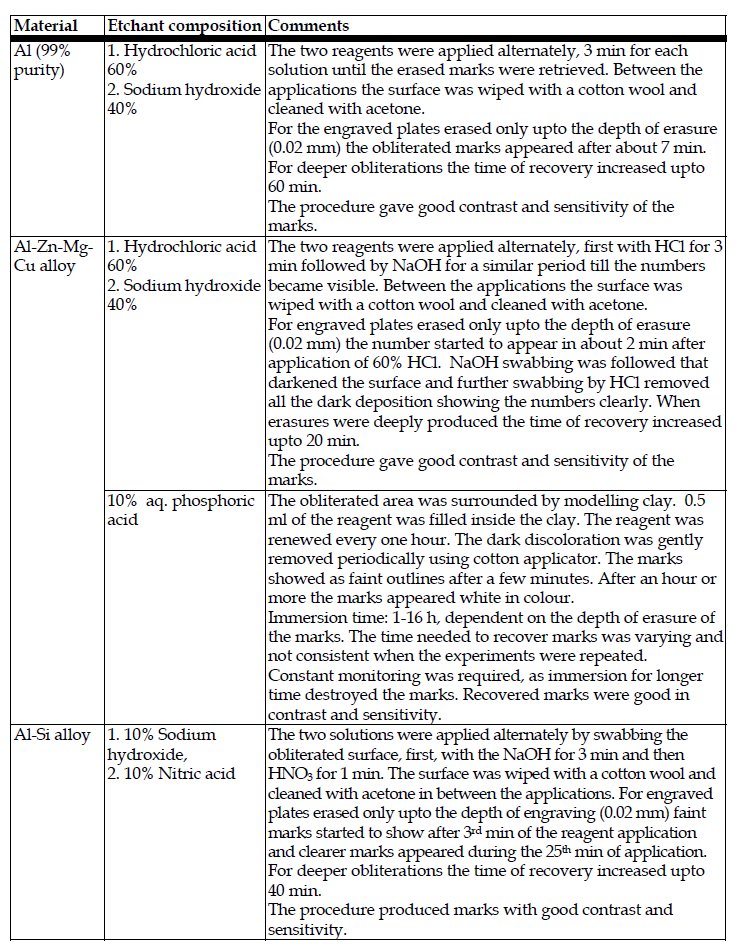
Alphabetical Index
Browse by Elements
Keyword Search
ASTM Electrolytes
Macro Etchants
Micro Etchants
Named Etchants
New Etchants
Al and Al Alloys
Cu and Cu Alloys
Fe and Fe Alloys
Ni and Ni Alloys
Carbide Etchants
Fluoride Etchants
Nitride Etchants
Other Etchants
Oxide Etchants
Phosphide Etchants
Single Crystal Etchants
Thin Film Etchants
Wafer Etchants
Help
Home
Aluminium and alloys - Restoration of obliterated marks
Material Name: Aluminium and alloys
Recipe No.: 12058
Primary Chemical Element in Material: Al
Sample Type: Bulk
Uses: Macrostructure
Etchant Name: See the table
Type (Macro/Micro): Macro
Etching Method: Chemical
Etchant (Electrolyte) Composition: See the tables 1 and 2.
Procedure (Condition): See the tables 1 and 2.
Note: A problem of common occurrence in forensic science is the restoration of obliterated serial
numbers on the chassis and engine of stolen motor vehicles, firearms, jewellery, valuable
tools, and machinery (Nickols, 1956; Wolfer & Lee, 1960; Jackson, 1962; Cunliffe & Piazaa,
1980; De Forest & Gaensslen, 1983; Schaefer, 1987; O’Hara & O’Hara, 1994; Moenssens et al
(1995); Heard, 1997; Petterd, 2000; Lyle, 2004; Katterwe, 2006; Seigel, 2007; Mozayani &
Noziglia, 2006; Jackson et al (2008); Levin, 2010). Serial numbers or other markings, which
are unique to that particular item, are usually marked on the above metal surfaces during
the manufacturing process. Criminals alter or obliterate these identification marks during
thefts or other illegal uses in order to prevent their identity. On many occasions a fraudulent
number would be introduced after removing the original one. In abandoned vehicles all
serial numbers are verified in order to detect alterations in the identity of the vehicle
(Svensson et al, 1981). Sometimes the serial numbers on firearms are removed more
professionally making it hard to distinguish whether the numbers are original or not
(Shoshani et al, 2001). Restoration of the original obliterated numbers provides important
forensic evidence in order to return the items to the owner and also to follow up the criminal
proceedings against the perpetrator. In cases involving firearms the recovered numbers
provide an important investigative lead. The history and the ownership of the firearm can be
obtained only from the serial number. In forensic practice a few experimental techniques are
being used successfully to restore the obliterated serial numbers on the above surfaces. The
methods include: chemical etching, heat treatment, magnetic particle, ultrasonic cavitation and relief
polishing (Nickols, 1956; Polk & Giessen, 1989; Maxwell, 1993; Heard, 1997; Hogan et al, 2006;
Katterwe, 2006). Nondestructive methods such as hardness testing, magnetic imaging, x-ray
imaging, eddy current, infrared imaging, scanning acoustic microscopy, electron channeling
contrast and thermal wave imaging are also proposed (Hogan et al, 2005; Katterwe, 2006;
Klees, 2009). However, chemical etching is most popular because it is sensitive, easy to apply
on any size and also kind of object and reproducible. Etching can be applied on all metal
surfaces including precious ones (Crowe & Smith, 2005).
Reference: From the book, Aluminium Alloys, Theory and Applications, Edited by Prof. Tibor Kvackaj, 2011, R. Kuppuswamy, Metallographic Etching of Aluminium and Its
Alloys for Restoration of Obliterated Marks in Forensic Science Practice and Investigations, www.intechopen.com, 2019, pp. 331-352.
Table 1: Etching reagents used to restore erased engraved marks on aluminium and its alloy
surfaces.

Click the table to enlarge the data.
Table 2: Reagents for etching Al (99% purity), Al-Zn-Mg-Cu and Al-Si alloys for restoration
of obliterated marks. The reagents were sensitive enough to recover the marks on the
engraved plates erased down 0.02 to 0.04 mm below the engraving depth. The marks
produced by the reagents were also reproducible.

Click the table to enlarge the data.